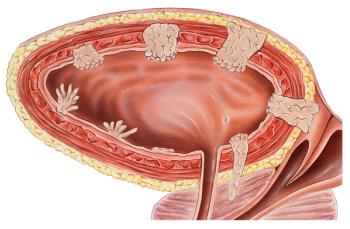
Robert H. Vonderheide, MD, DPhil, Discusses Genomic Correlates of Response to Chemoimmunotherapy in PDAC
Biosignatures data from the PRINCE trial show sophisticated precision approaches may be necessary to optimize chemoimmunotherapy use in pancreatic ductal adenocarcinoma.
At the
Results showed that several pretreatment tumoral gene expression signatures were predictive of survival with nivolumab plus chemotherapy with many predictive T-cell populations showing an activated, antigen-experienced phenotype, whereas pretreatment levels of CD4 T cells, B cells, and dendritic cells correlated to survival with sotigalimab plus chemotherapy. The 1-year overall survival (OS) rate in the nivolumab arm was 57.7%, which reflected a statistically significant improvement to historical controls (P = .006). In the sotigalimab arm, that rate was 48.1% (P = .062) and 41.3% in the triplet arm (P = .233).
Transcript
We reported that we met the primary end point [of 1-year OS] in patients who were treated with standard chemotherapy with the addition of nivolumab. This hasn’t been shown before. We also saw activity and just missed statistical significance with chemotherapy combined with a novel agonist to CD40 [P = .062]. There are 2 good possibilities with chemoimmunotherapy which, of course, is useful in other tumor types and now we have an idea that it might be beneficial in pancreas cancer. More importantly was that for each of those combinations, we were able to identify specific biomarkers that indicate which patients are more likely to respond to which therapy using a large translational research approach. [These markers are] distinct by arm. A biomarker-predicting response to chemotherapy/nivolumab can’t predict response to chemotherapy/sotigalimab, and vice versa. In fact, it appears there are different types of patients whom we can identify now—not by a tumor biopsy, sequencing, or some of the more traditional approaches to precision oncology—but rather taking a sample of blood and studying the immune subsets by flow cytometry and other techniques. To us, that represents a novel approach for precision oncology, particularly in pancreatic cancer, where we need to do better.
Reference
Padrón LJ, Maurer DM, O’Hara MH, et al. Distinct biosignatures associate with survival after chemoimmunotherapy in a randomized, three-arm phase II study in patients with metastatic pancreatic cancer. J Clin Oncol. 2022;40(suppl 16):4010. doi:10.1200/JCO.2022.40.16_suppl.4010
Newsletter
Stay up to date on recent advances in the multidisciplinary approach to cancer.


























































































